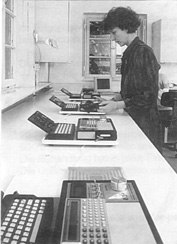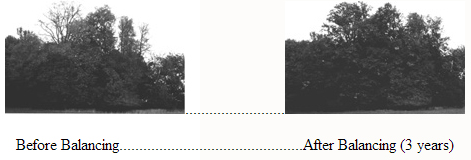Chapter 6
The Institute for Resonance Therapy, Germany
 The Institute for Resonance Therapy (IRT) began using Radionics in 1986 and was founded by Dr. Marion Graefin Hoensbroech. Their primary area of experimentation has been in the area of restoring forests in Germany and surrounding countries. They have done many double-blind studies which shows the beneficial effect of the SE-5. When they first began, they were using radionic equipment of almost every type and design. In 1987, ProNova Energetiks ( now Munovamus), a company that is representing the SE-5 plus in Germany demonstrated the instrument for them. After a demonstration of the SE-5, someone commented, “You are driving Cadillacs, and we are driving around in old Model Ts.” They promptly put their radionic instruments into the closet and purchased seven SE-5s. They realized the differences between Radionics, and the superiority of the SE-5. They now use 14 SE-5s in their work.
The Institute for Resonance Therapy (IRT) began using Radionics in 1986 and was founded by Dr. Marion Graefin Hoensbroech. Their primary area of experimentation has been in the area of restoring forests in Germany and surrounding countries. They have done many double-blind studies which shows the beneficial effect of the SE-5. When they first began, they were using radionic equipment of almost every type and design. In 1987, ProNova Energetiks ( now Munovamus), a company that is representing the SE-5 plus in Germany demonstrated the instrument for them. After a demonstration of the SE-5, someone commented, “You are driving Cadillacs, and we are driving around in old Model Ts.” They promptly put their radionic instruments into the closet and purchased seven SE-5s. They realized the differences between Radionics, and the superiority of the SE-5. They now use 14 SE-5s in their work.
The basics of using Radionics in agriculture were developed by Curtis P. Upton and his associates in the U.K.A.C.O., a company the was formed by Upton (see Chapter 5). His methods culminated in a study for the USDA in the 1950s. As you can see by the following chart in Fig. 6.2,* his methods seemed to work exceedingly well.
Before this study was completed, Dow chemical company began a similar study and had similar results. It makes one wonder why the USDA seemed so optimistic in one newsletter about the possibilities of using this technology before the studies were done by Upton and Dow, but didn’t even publish the results once they were finished with the studies. Edward Russell investigates this possible cover up in his book, Report on Radionics. (Published by C.W. Daniel, Essex, England)
Newer methods do not focus as much on getting rid of pests, but in building the soil, seeds and plants so that the plants are healthy and strong. It has been observed that healthy plants do not have the attractors to attract pests. It would appear that pests are actually a beneficial factor in the life cycle by eating up and destroying plants that are genetically weak. In the big picture nature has a self weeding process to ensure the survival of the fittest.
The methods developed by the IRT have demonstrated this point. They have determined that the introduction of pollution and chemical toxins from pesticides, herbicides, and other toxic waste is stressing the forest’s ability to adapt to change. Under normal conditions, the trees would adapt and integrate a change in hundreds to thousands of years. Now some forests are dealing with new compounds almost daily which makes adaptation nearly impossible. It would seem that forests with high vitality are able to adapt faster to the new information input of these compounds, and those of a lower vitality become sick and are die off. The ecosystem sends out a signal and through the process known in quantum physics as a subtle attractor, normally receives an answer and begins the adaptation. Now with the rapid changes, no signals are being returned.
The process of the Resonance Therapy reintroduces a new organizing informational field that recreates the possibility for the entire system to adapt and reorganize itself again. That does not mean that we can continue polluting our environment as we have up until now, because the reorganizing ability of the ecosystem will soon become exhausted. Organizing patterns of IDFs can only be offered to the system but it is within the system itself that must bring this new input into manifestation. Further, this information must be repeated as the system begins to accept the new pattern and adapt to the healthy informational structure.
According to Mandelbrot, the self repetition of a simple structure is the basis for many forms and complex structures in nature. Mandelbrot shows that through continuous repetition of a simple mathematical formula, complex forms of nature can be generated. (see Fig. 6.3)
Here you can recognize the principal that the order of the entire whole can be rediscovered in the simple, basic parts of itself. These mathematical formulas (fractals) contain a high level of information and are strong IDF resonators.
Beginning with a topographical map or aerial photograph of the area of interest, the IRT then makes an outline of the specific treatment area.
With the help of scanners, they digitize the information and plot it into the computer as a mathematical formula (fractal). The image is then manipulated in the computer to find the CRP (Critical Rotation Point) in the tradition of Abrams and De La Warr. Under the guidance of the local forest service, the IRT then begins to determine how large the surrounding area is, of which the forest is a part. In other words, the entire ecosystem must be treated as a whole in order to have success with the part (the forest).
After the appropriate IDF resonators have been determined by using the SE-5, they begin the balancing sessions. Presently the IRT is using 14 SE-5s, each equipped with a personal computer to balance the many projects they are working on. Two people monitor the results and determine the balancing sessions which normally run for two to four hours a day, five days a week. By constant monitoring it is being determined how long to balance the ecosystem and when to pause in the balancing to give time for the system to integrate the new information.
Detailed physical examination of foliage growth, new root development, the forest floor, leaf analysis, light measurements and tests of control trees in the surrounding area are done twice yearly. With the heavy burdens of our present pollution, forests usually need about three years of balancing before it is able to renew its self regulation processes again. The results of the balancing show themselves on many levels, i.e., the increase of humus on the ground, an increase of the number of plant species in the forest, better food supply for the trees, and increase of leaf mass. Interestingly, the animals in the area seem to sense the balancing and seek out food and nesting in the areas that are being balanced.
Another experiment that they carried out, was by done by taking a picture of one group of trees in a forest, and then sending IDFs to only this group. They monitored these trees for three years. They used a light meter and walked under the trees each year to see how much light was blocked by the tree’s leaves. The second year was a drought year, but as you can see from the chart in Fig. 6.7, the ‘SE-5’ trees were still improving, getting more leaves each year. To make the test even more difficult, the SE-5 trees started out in worse shape than the ‘normal’ trees. The normal trees had a huge decrease the second year and let through much more light. This is attributed to the drought. The third year, the ‘normal’ trees improved over the drought year, but were still in worse shape than the first year. The ‘SE-5’ trees steadily improved over each year. They have done many such studies and now government agencies from several different countries are now hiring the IRT to use the SE-5 on their forests.

In one experiment, the IRT potentized ten seeds with IDFs. They then planted them along side of 10 other ‘normal’ seeds. Ten days later they dug them all up and looked at the progress. The ten ‘SE-5’ seeds had sprouted and had quite long roots already, with many little feeder roots like small hairs off of each root sprout. The tops on many of the seeds had opened with the beginning of stems and leaves emerging. (See Color Plate I)
The ten ‘normal’ seeds didn’t have as many feeder roots. The largest and most developed seed of the ‘normal’ seeds, was not as well developed as the smallest of the ‘SE-5’ seeds! None of the seeds had opened at the top.
Here is another interesting experiment that the Institute performed. They connected a plant to an EEG, and with a photograph sample of the plant, drove with the SE-5, fifty Kilometers away, (about 30 miles). They then began balancing IDFs with the SE-5 and as you can see from the chart in Fig. 6.10 , there is a sharp increase after beginning the balancing, and it then continued to climb. The plant certainly was aware of the SE-5. The institute is continuing to do research in this area and is expanding in their work.
Fig. 6.10
Distance Balancing Experiment The IRT continues research in Germany, Austria, Russia, Czechoslovakia, and elsewhere. Many projects are fourty thousand hectares or more. The most important aspect of this research is that we realize we must stop the deterioration of our ecosystem!
I took off my headphones and studied the chart with interest. I was amazed that a plant was able to detect such subtle changes over that distance. I wondered if my body was also able to ‘pick up’ these small changes from informational fields as well. I concluded that life was much more strange and interesting than I had ever imagined.



